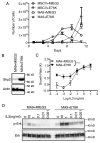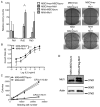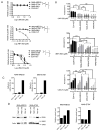Mutated Ptpn11 alters leukemic stem cell frequency and reduces the sensitivity of acute myeloid leukemia cells to Mcl1 inhibition
- PMID: 25650089
- PMCID: PMC4456293
- DOI: 10.1038/leu.2015.18
Mutated Ptpn11 alters leukemic stem cell frequency and reduces the sensitivity of acute myeloid leukemia cells to Mcl1 inhibition
Abstract
PTPN11 encodes the Shp2 non-receptor protein-tyrosine phosphatase implicated in several signaling pathways. Activating mutations in Shp2 are commonly associated with juvenile myelomonocytic leukemia but are not as well defined in other neoplasms. Here we report that Shp2 mutations occur in human acute myeloid leukemia (AML) at a rate of 6.6% (6/91) in the ECOG E1900 data set. We examined the role of mutated Shp2 in leukemias harboring MLL translocations, which co-occur in human AML. The hyperactive Shp2E76K mutant, commonly observed in leukemia patients, significantly accelerated MLL-AF9-mediated leukemogenesis in vivo. Shp2E76K increased leukemic stem cell frequency and affords MLL-AF9 leukemic cells IL3 cytokine hypersensitivity. As Shp2 is reported to regulate anti-apoptotic genes, we investigated Bcl2, Bcl-xL and Mcl1 expression in MLL-AF9 leukemic cells with and without Shp2E76K. Although the Bcl2 family of genes was upregulated in Shp2E76K cells, Mcl1 showed the highest upregulation in MLL-AF9 cells in response to Shp2E76K. Indeed, expression of Mcl1 in MLL-AF9 cells phenocopies expression of Shp2E76K, suggesting Shp2 mutations cooperate through activation of anti-apoptotic genes. Finally, we show Shp2E76K mutations reduce sensitivity of AML cells to small-molecule-mediated Mcl1 inhibition, suggesting reduced efficacy of drugs targeting MCL1 in patients with hyperactive Shp2.
Conflict of interest statement
The authors declare no conflict of interest.
The authors have no competing financial interests.
Figures







Similar articles
-
Cooperation of MLL/AF10(OM-LZ) with PTPN11 activating mutation induced monocytic leukemia with a shorter latency in a mouse bone marrow transplantation model.Int J Cancer. 2017 Mar 1;140(5):1159-1172. doi: 10.1002/ijc.30515. Epub 2016 Nov 25. Int J Cancer. 2017. PMID: 27859216
-
MLL-AF9 and FLT3 cooperation in acute myelogenous leukemia: development of a model for rapid therapeutic assessment.Leukemia. 2008 Jan;22(1):66-77. doi: 10.1038/sj.leu.2404951. Epub 2007 Sep 13. Leukemia. 2008. PMID: 17851551 Free PMC article.
-
The CDK9 Inhibitor Dinaciclib Exerts Potent Apoptotic and Antitumor Effects in Preclinical Models of MLL-Rearranged Acute Myeloid Leukemia.Cancer Res. 2016 Mar 1;76(5):1158-69. doi: 10.1158/0008-5472.CAN-15-1070. Epub 2015 Dec 1. Cancer Res. 2016. PMID: 26627013
-
Shp2 function in hematopoietic stem cell biology and leukemogenesis.Curr Opin Hematol. 2012 Jul;19(4):273-9. doi: 10.1097/MOH.0b013e328353c6bf. Curr Opin Hematol. 2012. PMID: 22504523 Free PMC article. Review.
-
Learning from mouse models of MLL fusion gene-driven acute leukemia.Biochim Biophys Acta Gene Regul Mech. 2020 Aug;1863(8):194550. doi: 10.1016/j.bbagrm.2020.194550. Epub 2020 Apr 19. Biochim Biophys Acta Gene Regul Mech. 2020. PMID: 32320749 Review.
Cited by
-
Venetoclax Combined with Intensive Chemotherapy: A New Hope for Refractory and/or Relapsed Acute Myeloid Leukemia?J Clin Med. 2024 Jan 18;13(2):549. doi: 10.3390/jcm13020549. J Clin Med. 2024. PMID: 38256681 Free PMC article. Review.
-
Impact of PTPN11 mutations on clinical outcome analyzed in 1529 patients with acute myeloid leukemia.Blood Adv. 2021 Sep 14;5(17):3279-3289. doi: 10.1182/bloodadvances.2021004631. Blood Adv. 2021. PMID: 34459887 Free PMC article.
-
Inflammation: a key regulator of hematopoietic stem cell fate in health and disease.Blood. 2017 Oct 12;130(15):1693-1698. doi: 10.1182/blood-2017-06-780882. Epub 2017 Sep 5. Blood. 2017. PMID: 28874349 Free PMC article. Review.
-
Enhancing venetoclax activity in acute myeloid leukemia by co-targeting MCL1.Leukemia. 2018 Feb;32(2):303-312. doi: 10.1038/leu.2017.243. Epub 2017 Jul 28. Leukemia. 2018. PMID: 28751770
-
Adapted to Survive: Targeting Cancer Cells with BH3 Mimetics.Cancer Discov. 2022 May 2;12(5):1217-1232. doi: 10.1158/2159-8290.CD-21-1334. Cancer Discov. 2022. PMID: 35491624 Free PMC article. Review.
References
-
- Raimondi SC, Chang MN, Ravindranath Y, Behm FG, Gresik MV, Steuber CP, et al. Chromosomal abnormalities in 478 children with acute myeloid leukemia: clinical characteristics and treatment outcome in a cooperative pediatric oncology group study-POG 8821. Blood. 1999 Dec 1;94(11):3707–16. - PubMed
-
- Rubnitz JE, Link MP, Shuster JJ, Carroll AJ, Hakami N, Frankel LS, et al. Frequency and prognostic significance of HRX rearrangements in infant acute lymphoblastic leukemia: a Pediatric Oncology Group study. Blood. 1994 Jul 15;84(2):570–3. - PubMed
-
- Bitoun E, Oliver PL, Davies KE. The mixed-lineage leukemia fusion partner AF4 stimulates RNA polymerase II transcriptional elongation and mediates coordinated chromatin remodeling. Hum Mol Genet. 2007 Jan 1;16(1):92–106. Epub 2006/12/01. eng. - PubMed
Publication types
MeSH terms
Substances
Grants and funding
LinkOut - more resources
Full Text Sources
Other Literature Sources
Medical
Molecular Biology Databases
Research Materials
Miscellaneous

